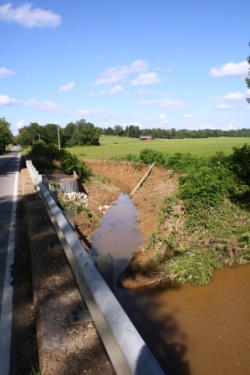 Bridge over Highway 58 in Graves County. Once there was a grove of trees at this spot.
Ravaging rains, sometimes as much as 4” to 8” falling in one storm, have escalated the debate over who pays for storm damage. New concerns at the public government levels are growing over how much structural damage is being caused by massive new storm waters runoff in public places.
Two examples of this new public question can be seen in far Western Kentucky counties of Graves and Hickman.
In the city of Clinton, Kentucky, 60% of its one square mile of corporate geography is used for row crop farming. This includes corn, wheat, and soybean crops. During the past eight months any tree line, watershed, or natural wet lands of farms located within the City of Clinton have been stripped and the remains burned.
One area in northern Clinton has a low spot where farm land meets dense home and street structures. The new “normal” after heavy storms is that much of this area is now flooding. Homes, streets, and walkways are now at serious risk of being lost to water damages from new intense storm waters.
An estimated engineer costs to fix this new water problem starts at $100,000 dollars.
A second example of new storm water problem can be seen along State Highway 58, just past the Hickman County and Graves County line. Several hundred acres of land were stripped of tree lines, watersheds, and natural patterns of water run off.
The result is that a highway bridge may be in serious danger from new large volumes of storm waters runoff. The collapse of the bank of utility lines and poles can be seen from the road.
What had been a small two feet wide creek bed has now turned into a twenty feet by fourteen feet deep water shoot that is increasing stress all along the support beams and structures for the county bridge. To replace this bridge probably would cost somewhere between $ 500,000 to $ 1,000,000 dollars.
The new question for governments, state, county and urban, is who will pay for the damages to public structures, those who removed the water barriers or the taxpayer? |







